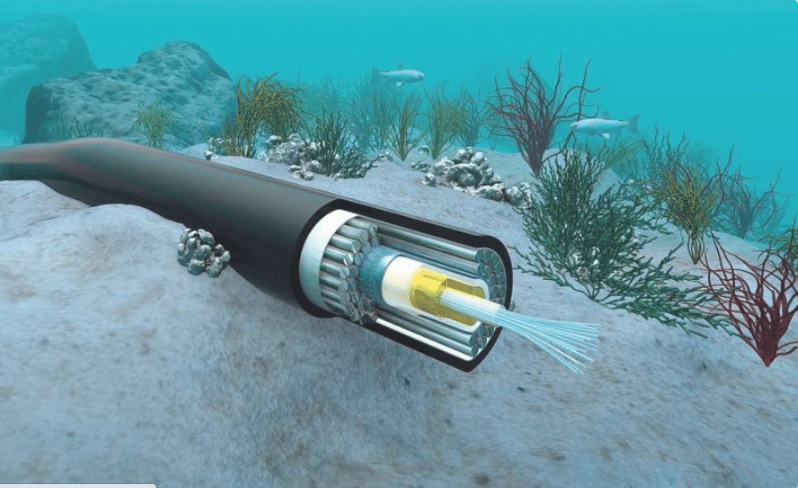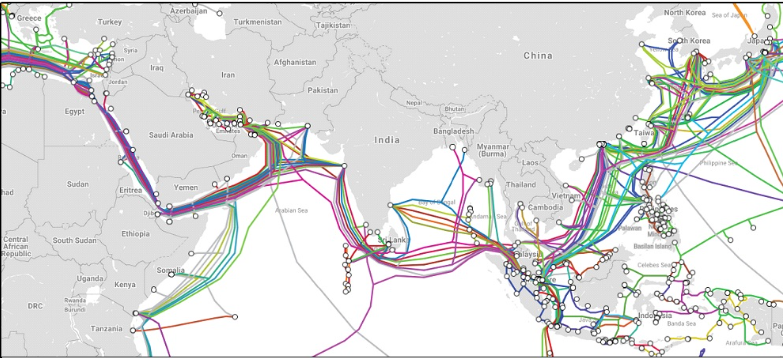ForumIAS announcing GS Foundation Program for UPSC CSE 2025-26 from 19 April. Click Here for more information.
Recently, the damage to submarine cables in the Red Sea, has exposed the vulnerability of Indian Telecom Sector. Three submarine cables connecting India to Global Telecom Networks- Asia-Africa-Europe-1, Europe India Gateway, and Tata Global Network– have been damaged due to targeted attacks. Major Indian Telecom operators such as Bharti Airtel, Reliance Jio and Tata Communications have been forced to reroute traffic to other cable systems.

What is submarine cable system connecting India with rest of the world?
Submarine Cable System- It is a ‘line link‘ in the form of wire, cable, optical fibre, tube, conduit, waveguide or other physical medium. It is for carrying communications by means of guided electromagnetic energy.
Rapid technological advancements have transformed the submarine communications cable from a copper-based telegraph cable in 1850 to advanced fibre-optic cables today. The cables connect continents across the globe.

However, India’s legislations do not comprehensively define submarine cable systems. There has also been a dearth of definition of submarine cable systems at the international level.
Types- The submarine cables are of two types-
a. Submarine communications cables- For Communication and internet connectivity
b. Submarine power cables- To transmit power from one place to another
How are the submarine cable systems laid?
Submarine cable system-
a. Cable Station at the ground contains the servers from/to which data is to be transmitted. All the armoured submarine cables are connected to the cable station.
b. Cables that are laid at depths shallower than 1500m, are buried 60 cm under the sea bed to prevent them from damages such as anchoring of ships, mining and dredging.
c. Cables at depth exceeding 1500m, are simply laid upon the seabed and not buried as there are fewer chances of accidental damages at such depths.

Submarine cable management in India- Indian government provided the private players the opportunity to provide international telecommunication links in 2002. These private players are known as International Long Distance (ILD) providers.
Currently, there are 16 operational submarine cable systems in India. Additional, 4 cable systems have been planned.
| Read More- TRAI’s recommendations for Submarine Cable Landing in India |
What are the vulnerabilities of India to damage to underwater cable systems?
1. Substantial Loss to Indian service sector- India’s service sector like the Business Processing Units are entirely dependent on Global connectivity for their operations. Any damage to submarine communications cable, leads to substantial losses.
For ex- The severance of multiple undersea cables off the coast of Egypt and Dubai in 2008, led to loss of more than 80% of India’s international service.
2. Threat to India’s Financial Stability- India’s banks use SWIFT system for international financial transfers and banking operations. This SWIFT system relies on undersea fibre-optic cables to transmit more than 15 million messages a day, valuing $10 trillion of financial transfers to 208 countries.
3. Disruption of Social security schemes- Indian government’s social security schemes based on the JAM trinity is heavily dependent upon the modern internet. Any disruption of these undersea cables will cause major disruptions in the implementation of these schemes.
4. Military and National Security- India’s national security is also dependent on underwater cable communications systems for real time communication.
What are the threats to these Cable Systems?
1. Lack of route-diversity- The route of undersea cables from Red Sea to Mediterranean through mainland Egypt, is the world’s largest internet choke points. This route is susceptible to interdictions/interjections. For ex- Five interdictions to the cables in the Red Sea region would completely isolate India from Europe.
2. Sabotage by Non-state actors- The non-state actors have been involved in intentional and targeted damage to undersea cables. For ex- Houthi rebels involvement in targeting submarine cables in the Red Sea region.
3. Human activities like fishing and dredging- Fishing like bottom trawling and dredging operations cause damages to unarmoured submarine cable systems at the ocean bottom.
4. Offshore activities- Offshore activities like oil and gas development, the setting-up and maintenance of infrastructure for offshore wind energy and ocean-thermal plants, seabed mining operations also cause damage to submarine cable systems.
5. Natural disasters- Natural disasters such as earthquakes, tsunamis, typhoons, and subsea landslides, also pose significant threats to undersea cable networks.
What should be the way Forward?
1. Comprehensive definition of Submarine Cable System- The Indian Telegraph Act of 1885 should be amended for a comprehensive definition of undersea cable system, which includes ‘international’ submarine cables connecting India to places outside India. For ex- Australia’s Telecommunications Act 1997 which provides the legal regime for the protection of international submarine cables landing in Australia.
2. Inclusion in Critical Information Infrastructure System (CIIS)- Submarine communications cables landing in India be included within India’s ‘Critical Information Infrastructure System‘ (CIIS).
3. Exercising ‘protective jurisdiction’- India must exercise prescriptive jurisdiction over undersea cables using the principle of “protective jurisdiction” under the High Seas.
4. International legal and regulatory mechanism- International legal and regulatory mechanism must be developed to prevent these undersea cables from damage and interception. For ex- Agreement among governments to protect underwater infrastructure and subsea cables after Nord Stream gas pipeline explosions.
5. Early completion of sea cables- The separate sea cable projects of internet giants like Google, Facebook, and Microsoft must be completed at the earliest to reroute communications in cases of failure.
6. Securing the internet choke points- The geographical location of Egypt, which makes it the centre of Europe and Asia’s internet connections, can’t be changed. Hence, we must aim to secure this internet choke points by building extra landing sites like Ras Ghareb, and concrete duct tubes for the cables.
| Read More- The Hindu UPSC Syllabus- GS 2- International Relations |




